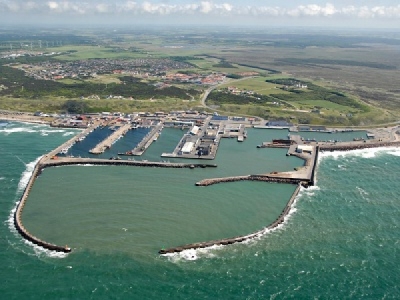
Posted on September 7, 2017
By Dag Pike, MJ
There is considerable expansion activity at Danish ports partly to cope with accommodating larger ships and partly to cope with increasing trade. Another spur for expansion has also come from the increased activity on wind farm construction in both the North and the Baltic Seas where Denmark has become a focus for the industry.
The Port of Esbjerg has undergone a major transformation with wind farm activity with a large section of the port now given over to this activity. However cargo handling has not been ignored and a significant expansion on this front is scheduled for completion at the end of this year. Construction work on an extension of the existing Libra Quay started in January this year and will provide for a new mooring pier and the establishment of two new Ro-Ro ramps. The site for this development is located adjacent to the main wind farm equipment handling centre that is operated by Vestas.
Work on the current expansion is being carried out by Danish contractors C.G. Jensen and comprises an enclosed rock armoured wall along its southern edge and sheet steel piling along the future berths. The infill for the reclaimed land will come from the maintenance dredging operations in the port that maintain the main channel depths at 10.5 metres for shipping. The two Ro-Ro berths will be on the reclaimed section with a large area of adjacent hard standing that will extend to 250,000 square metres. Ro-Ro shipping accounts for much of the cargo handing taking place at the port including the handling of wind farm components.
The Port of Esbjerg has also initiated a process to further clarify the expansion possibilities at the port as it expects increased activity towards 2030. It is anticipated that within the next few years, the expectation is that the port’s current areas and quays will be fully utilised. To be able to meet future demand, the port said it needs to expand with an additional approximately 1 million square meters of land and 1km of additional quay length between 2022 and 2030.
“We anticipate growing demand for areas at the port.” commented Ole Ingrisch, Director at the Port of Esbjerg. “Therefore, we must prepare for the future and clarify the possibilities for continuing a stepwise expansion of the port.” The formal environmental impact assessment process, including public consultations, is expected to start in the early autumn.
The Port of Esbjerg has a current area of 4.5 million square metres. Last year the cargo turnover was 4.5 million tonnes, with 6.626 ship calls. Esbjerg has undergone a major transformation from being mainly a fishing port and handling exports of agricultural produce to three dominant business areas today which are intermodal transport, wind farm operations and oil/gas exploration support. Proposals for new port facilities include expanding the new section currently under construction and developing a new quay area on the Island of Fano side of the approach channel.
On the East Coast of Denmark the Port of Kalundborg is taking a decisive step toward its vision of growth through a €26 million port expansion. This will make Kalundborg the largest deep-sea port and hub for container shipping in the Greater Copenhagen area.
Ny Vesthavn will be a new 330,000 square metre facility with 500 metres of dock and a 15 metre water depth in the approach channel. The dredging work will include the removal of 900,000 cubic metres of spoil. Bids have been received for both the construction and dredging work with work expected to start early next year. The aim is to expand the container shipping and feeder traffic as well as provide facilities for new industries.
“Deep water is an important future issue, and we want to invest in the future,” said the Port CEO, Bent Rasmussen. “But we have run out of space for port-using companies to establish themselves.
In order to fulfil the enormous growth potential of the port and the area we will now expand with more square metres and increased water depth enabling new companies to settle as well as securing the port and the surrounding business cluster to keep contributing actively to further development.”
In Northern Denmark on the West Coast there are plans to expand the port of Hanstholm Havn. This port was opened in 1967 and today it is mainly a fishing port with the largest fish landings in Denmark. Recent years have seen activity in wind farm construction support and in the past it has been the base for ferry services to Norway. The expansion plans will see the port add a considerable new area of land and quays that are designed to increase the port activity which is currently nearing saturation.
Hanstholm Havn is built out from the shore and its location at the northern end of Denmark means that it is exposed to westerly gales. This has led to uncomfortable motions in the harbour during adverse weather and one of the prime reasons for the expansion is to gain more protection for the port. The expansion will see a new northern breakwater extending out from the shore and this will curve round to provide protection for the new quay. It will have a curved T-head to break up the waves and on the south pier a new spending beach will be created to absorb wave energy.
The new quays will align with the existing inner breakwater line and they will enclose a considerable hard standing area that will be suitable for a number of uses. It is hoped that the port will now have space to attract wind farm components and assembly that can be directly shipped out but the quay will also be suitable for handling container cargoes or as the base for a ferry service. The additional space inside the new breakwaters will add about one third to the harbour area.
Source: MJ





